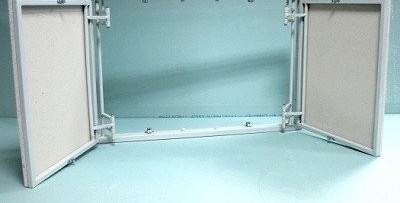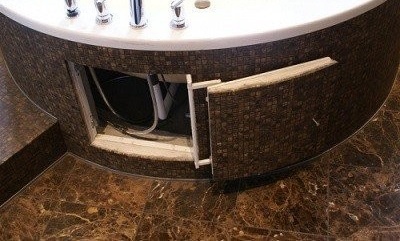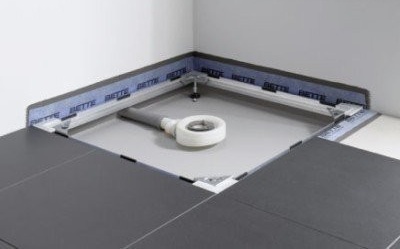Revision hatches: how to organize access to communications
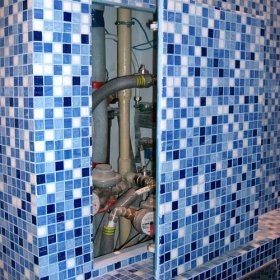
Comfort in the house is ensured by well-designed and high-quality installed heating, water, electricity, sewage, ventilation systems, which implies the presence of pipes and wires. So that they do not spoil the interior, they are masked for finishing materials, and for free access to communications, invisible revision hatches are installed. The niche in the wall is closed with the help of a built-in structure, the external part of which is finished with the same materials as the walls or partitions. Doors open easily, access to communications is maximally simplified.
Content
Designs of inspection hatches
Revision hatches are used to mask taps, valves, counters, pipes, ventilation elements, filters. They consist of a support frame and a door mounted on hinged hinges. Doors are most often made of moisture resistant gypsum board, on which any type of finishing material is easily attached. On sale you can find products with drywall doors. As a rule, they are cheaper, but experts do not recommend choosing them because of their lower durability.
Hatches are available in different sizes, depending on what specific technological niches they are intended for. Models differ in the type of door opening:
- swinging;
- push;
- folding;
- movable.
Most models are single-door, but there are also two-door ones. They are recommended to be installed if the width of the niche is more than 700 mm in order to protect the doors from sagging. If it is envisaged that the doors will experience significant loads, special reinforced structures can be purchased or ordered.
Swing hatches: the most popular option
The product consists of a sturdy steel frame and a door attached with two hinges. When the hatch is closed, the hinges are not visible, they are folded inside the frame. The external surface of the product is smooth and can be finished with the same tiles as the wall. Technological holes are provided in the frame, thanks to which the hatch is installed using dowels. Doors in the closed state hold roller wedge latches.
When choosing the size of the hatch, it is desirable that it matches the size of the tile, but this is not necessary if the difference is small. The main thing is that the tile is not smaller, but at the same time it does not hang more than 50 mm outside the door. Too much overhang will prevent the door from opening. The technological gap should be the same as the inter-tile seam, it is not filled with grout.
If the size is selected correctly and there are no errors during installation, the hatch will be completely invisible on the wall surface. You can open it using special suction cups. They are usually included in the hatch. Suction cups are applied to the tile, lightly pressed to fix, pull the doors on themselves, and then open. The door first frontally extends, the hinges unfold, and the hatch opens so that it does not touch the tile on the wall. Thanks to this opening system, the hatch can be mounted in any part of the wall where there is enough space for the door to open, even in the corner.
Swing hatches with suction cups are used if the tile is smooth. The suction cups do not stick to the rough surface. In this case, it is better to choose a different model.
Press models for embossed and rough tiles
The ideal mechanism for corrugated types of tiles, natural stone and mosaics. If the surface of the finishing material does not allow gluing the suction cups, it is better to give preference to push models. The door opens in the same way as the hinged door - it is slightly pushed forward, and then swings open, but instead of the suction cups, a push mechanism is used.
To open such a door, you need to slightly press on it with your palms - it will slide out, two-link loops will unfold. Then you need to pull on and swing open. The palms on the door should be placed symmetrically, you need to press with both hands, smoothly.
Sliding hatches - option for hard-to-reach spots
These models are equipped with three-link hinges, thanks to which the doors are shifted to the side. This option is recommended to be used if the technological niche is located in an inaccessible place and there is an obstacle in front of it (for example, a wall of furniture, a toilet bowl, household appliances, etc.). When opening, such a door extends 12 mm forward, after which it can be moved to the side without hooking the finishing materials on the wall.
The type of door opening is selected depending on the surface of the finishing material. For smooth tiles, it is better to choose suction cups; for mosaics, stone, rough tiles, a push mechanism is suitable. The door in the closed position is fixed with a roller-wedge or roller-push lock. Latches are strong, durable, reliable, spontaneous opening is excluded. The structure is attached to the wall with self-tapping screws or dowels.
Sliding models for wide technological niches are better to choose two-door. If the niche is high (1000 mm and above), it is better to choose a different type of hatch, for example, hinged. This is due to the fact that multi-link hinges at high load lead to door play.
Folding models - simple and functional
The peculiarity of hinged plumbing hatches is that the doors can not only open, but also can be removed. These models can be installed in hard-to-reach places where there is not enough space either for swinging open or for sliding the door. In the hinged models, the doors open at an angle with the help of suction cups, are held on carabiner chains and can be completely removed from the hinges and guide supports. The niche opens completely, and the outer part of the hatch is removed along with the finishing material. Neighboring tiles are not affected or damaged.
On hinged hatches stick tiles. They can protrude 50 mm from the top or sides, but from the bottom - a maximum of 10. It is also important to calculate the size of the hatch so that the removable door with tiles does not turn out to be too heavy. If the condition of communications in a niche is checked frequently, it is likely that when you remove the door, it will be dropped and decoration materials damaged. For frequent control it is better to choose sliding structures. The use of hinged hatches is justified only if other types cannot be installed.
Heavy-duty reinforced hatches
For rooms in which the walls are finished with heavy materials, it is necessary to select reinforced hatches. Standard structures can be damaged if you use marble, granite, porcelain stoneware as a finish, or if you install too large doors. The reinforced structure is made of steel pipe, has additional stiffening ribs, and is usually opened with suction cups.
Experts do not recommend the use of push mechanisms for such hatches, since it is difficult to press all latches simultaneously with the necessary force. Reinforced structures with increased carrying capacity are installed in cases where the total weight of the door and facing material is 40 kg or more. Doors of less weight do not require reinforcement; standard frames and mounts can be used.
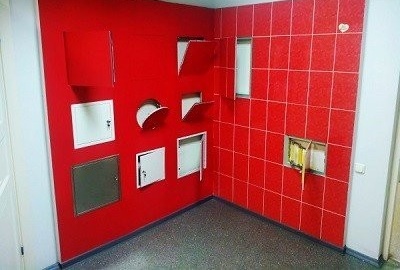
Invisible revision hatches can be of various designs, shapes and sizes. You should choose based on the purpose, location of technological niches and personal preferences of the owner of the house
Installation of invisible hatches
A detailed film instruction for the installation of inspection hatches will be offered below, so we will dwell only on the main stages of work:
- It is necessary to prepare an opening in which the frame will then be installed. If the niche is too large, it is reduced to the desired size using a metal profile.
- The hatch is placed in the opening, leveled, fixed with wedges and fixed around the perimeter with dowels or self-tapping screws.
- Facing materials are mounted on the hatch door.
- A masking tape is glued around the perimeter from the outside and inside, leaving a gap of 2-3 mm, the seam is filled with sealant to the entire depth. The color of the sealant must be chosen the same as the grout, so that after installation the location of the hatch does not stand out on the wall.
- Excess sealing compound must be removed and masking tape removed.
- After the sealant has dried, the seam is cut to the full depth, after which the hatch is ready for use.
Invisible revision hatches allow preserving the integrity and overall style of the room. Communications are not visible, but access to them is provided. At any minute, you can check the pipes, valves, taps, if necessary - to repair, without damaging the appearance of the decoration. These are convenient and practical designs that provide comfort in the home without compromising the interior.
